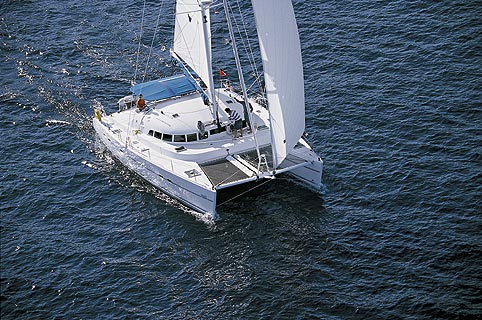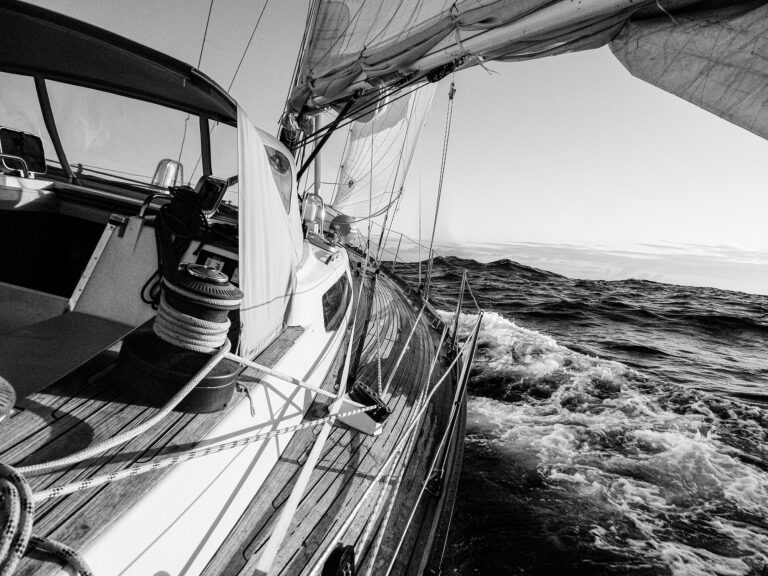
Designers Marc Van Peteghem and Vincent Lauriot Prévost took the strengths and weaknesses of the older Lagoon 47 and created a multifaceted multihull, ready to play the role of a liveaboard, charter boat, or long-distance cruiser. The transition from the Lagoon 47 to the Lagoon 470 entailed a major hull and deck redesign and a new approach to the use of space below, resulting in a truly new boat.
The older Lagoon 47 was popular in the charter trade, and a feedback loop among clients, skippers, and the builder set the stage for modifications that would benefit the new boat. A good part of the reason for the success of the Lagoon 470 lies in how effectively the builder and design team, rather than simply starting from scratch, used this accumulated history in the evolutionary design and construction of a new sailboat.
With an overall length of over 47 feet and nearly 26 feet of beam, there’s room on deck and below to keep guests and friends enjoying themselves and out of each other’s personal space. There’s also an efficient davit arrangement astern for a decent-sized RIB and plenty of stowage for dive gear, windsurfers, and other essentials of tropical living.
Beneath the upscale gleam of brightwork and decorator-chosen fabrics lies the nitty-gritty of a carefully crafted sailboat. In this case, it’s a story of well-chosen materials and even better quality control in the factory. When I first stepped aboard the Lagoon 470 during this year’s Boat of the Year contest, I noticed that the glasswork looked like aircraft quality even in the hidden spaces. In tight transom corners and up under the hull/deck flange are my favorite places to shine a flashlight beam to look for rough edges, poor bonds, voids, and other signs of sloppy workmanship. From stem to stern, the Lagoon was effectively engineered and put together with a healthy dose of due diligence.
Construction Quality
One of the key factors contributing to the quality of the FRP laminate was the experience of the builder, CNB Marine, located in Bordeaux, France. It’s a yard accustomed to high-end boatbuilding and one that’s familiar with vacuum bagging and resin-infusion molding. Add to this its use of vinylester resin and a crew well trained to handle composite sandwich structures.
When it comes to building cruising boats with core material, resin infusion offers two big pluses. The first is a higher fiber-to-resin ratio, which yields a stronger, lighter, better-bonded composite structure. The second is in the way resin infusion fills the kerfs, or slots, between the checkerboardlike cuts in the core. With vacuum bonding, atmospheric pressure acts as a giant vise that forces resin into the core slots and eliminates future avenues for water ingress.
The edge of the deck isn’t cored, and this solid perimeter lands on an inward-turning flange on the hull. The overlap is secured with Sikaflex, and the joint is also mechanically fastened with stainless-steel compression rivets. Like the rest of the boat, the hull/deck joint is well engineered and capably executed.
One of the most noticeable changes from the old Lagoon 47 to the new Lagoon 470 is in the shape of the deckhouse itself. In the new design, there’s a vertical leading edge that combines with 14 windows to greatly enhance visibility and lessen the greenhouse effect associated with the old boat’s sloped leading edge to the deckhouse. However, one side-effect of the new cabin design is it’s exposure to boarding seas in extreme, storm-tossed oceanic conditions. Many multihull experts recommend deploying a sea anchor from the bow in extreme conditions, and this tactic would expose the leading edge of the house to the full brunt of each breaking sea. Representatives of the builder stated that extra reinforcement has been placed in the vertical members between each window and that the windows themselves are securely held in place with a high-tech adhesive sealant.
Under Sail
The no-nonsense double-headsail fractional sloop rig stands 69 feet above the water and spreads a working sail plan of 1,292 square feet, including the genoa. I found the 807-square-foot mainsail easy for a medium-size crew to reef and handle, thanks to effective control lines and a traveler that extends across nearly the full beam of the boat. This is a really good-sized mainsail; the smaller the crew, the more attentive one needs to be about not letting a quartering breeze build to half a gale before thinking about tucking in a reef. As with most cats, the traveler control line plays a key role in adjusting trim for each minor change in angle of attack, and even though most cruisers aren’t overly interested in vertical wind shear and trimming a mainsail to cope with this nuance on opposing tacks, it’s nice to see a boat with a traveler, sheet, and vang arrangement that’s makes it an easy task to accomplish.
The steering was smooth and responsive, and the single helm’s port location worked well in conjunction with the simple yet protective tubular bimini top. Good visibility made the helmsman’s role a lot easier, and sheets terminated nearby for convenient sail trim. The big cat showed a willingness to come through the eye of the wind without much hesitation, and the lateral plane derived from the small keels lessened leeway and improved the boat’s pointing ability. She didn’t climb to weather as well as boats with deep daggerboards, but the loss of this small amount of windward ability will be considered a fair trade by those uninterested in pulling lines to hoist and drop the daggerboards when sailing to windward.
When you’re reaching under mainsail and genoa and the Lagoon 470 sees the south side of 10 knots of breeze, she begins to bog down; three choices come to mind. Option One is to kick back and keep plugging along with the monohulls and all but the ultralight cats and trimarans. Alternative Two is to wind up the jib and fire up the smooth-running Yanmars, giving you an instant 8-knot option. Third is the best option of all: a good complement of light-air sails. Consider an optional gennaker or spinnaker package and up the sailing pleasure quotient by a significant amount. A snuffer sock for the asymmetric spinnaker and a furling unit for the drifter/ code zero can really make these sails much easier to handle. The Lagoon 470 is light enough (about 10 tons light trim) to respond to the sail-area increase, and the builder offers running rigging and hardware that makes light-air sailing even more user-friendly.
Power and Systems
Twin naturally aspirated Yanmars are fitted with saildrives. Standard 40-horsepower engines will push the boat at hull speed in a calm, but for those who often find time constraints impeded by a landfall that lies directly to windward, 56-horsepower Yanmars may bridge the gap. Both engines will use about the same amount of fuel at speeds common to both engines.
Tankage is a big issue in multihulls for several reasons, not the least of which is the weight of fluids and the performance-robbing nature associated with overloading lean, long hulls. Once again, Lagoon finds a moderate compromise, with fuel and water providing mirror-image capacity in each hull that adds up to 158 gallons of water and 126 gallons of fuel. Those who fit out a watermaker might want to flip-flop the fuel and water stats. The 15-gallon holding tank may meet the letter of the law, but with up to four cabins’ worth of company on board, daily pumpouts would become an unwelcome ritual.
Lagoons headed for the States go through an equipment upgrade custom blended for the North American market. In the case of the Lagoon 470 we sailed last fall, it included a Profurl headsail-furling system, a Lofrans 1,500-watt anchor windlass, an extensive Raymarine electronics package including radar and GPS, and other pieces of gear with equally proven track records. An 11.5-kilowatt Onan and a Mastervolt inverter set the energy stage for refrigeration and the potential future addition of a watermaker and other electrical equipment.
CNB built the Lagoon 470 to ISO standards for Category A certification; this means the vessel must meet specific standards regarding structure, equipment, and stability. The vessels are delivered to North America on their own bottoms, and the transatlantic passage is an indication of the boats’ trade-wind ability. The delivery adds about $15,000 to the price of the vessel, and a good way to put those dollars to better use is to take delivery in France and sample a bit of cruising in Europe before sailing the boat to your home port.
Accommodation Plans
The charter-layout option is a four-bedroom/four-bath home afloat, sporting a roomy bridgedeck saloon that houses a spacious galley to port and an elliptical table and settee to starboard that comfortably seats eight and can be packed with 10 in a pinch. Two options are offered as personal-use layouts, one with a galley-down arrangement and the other a galley-up arrangement similar to the charter option. Heads are reduced to three, and all layouts provide a forward-facing chart table with enough room for electronics and some chart stowage.
There’s a clean, bright, functional flair to the styling below, and the computer-aided design and manufacture (CAD/CAM) of the joinery has helped optimize visual appeal and still keep unnecessary pounds from piling up. The interplay between the raised deck and the spacious deckhouse affords plenty of headroom in the passageways, wide berths, and a sense of roominess not often found aboard four-cabin layouts on multihulls under 50 feet. Another big plus offered by a custom builder doing a production line of boats is the company’s willingness and ability to do interior options. We hear that there will soon be six interior layouts available for 2003 models.
In addition to these styling innovations, the Lagoon 470 features a commonsense approach to boatbuilding that keeps the boat light enough to keep sailors smiling while including a hull capable of handling intentional and unintentional beaching. The R&D work done by parent company Groupe Beneteau has also been leveraged to benefit buyers. For example, when it comes to rigging and other highly stressed components, Beneteau’s laboratory testing has given the builder valuable data that’s helped identify the right hardware for a specific job, a feature that gives boat owners more trouble-free years of sailing down the line.
Ralph Naranjo is Cruising World’s technical editor.








